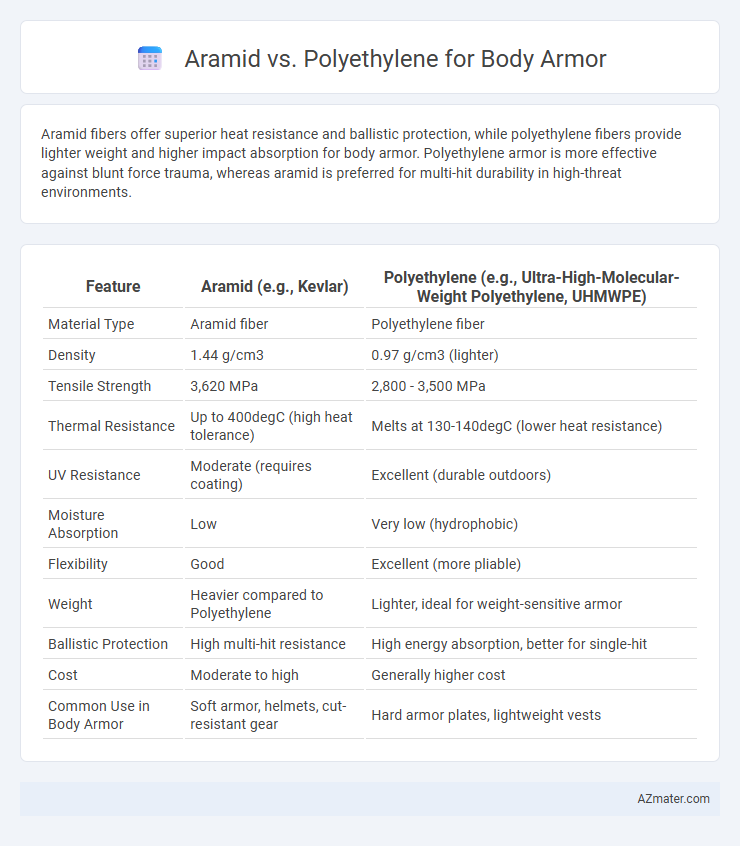Aramid fibers offer superior heat resistance and ballistic protection, while polyethylene fibers provide lighter weight and higher impact absorption for body armor. Polyethylene armor is more effective against blunt force trauma, whereas aramid is preferred for multi-hit durability in high-threat environments.
Table of Comparison
| Feature | Aramid (e.g., Kevlar) | Polyethylene (e.g., Ultra-High-Molecular-Weight Polyethylene, UHMWPE) |
|---|---|---|
| Material Type | Aramid fiber | Polyethylene fiber |
| Density | 1.44 g/cm3 | 0.97 g/cm3 (lighter) |
| Tensile Strength | 3,620 MPa | 2,800 - 3,500 MPa |
| Thermal Resistance | Up to 400degC (high heat tolerance) | Melts at 130-140degC (lower heat resistance) |
| UV Resistance | Moderate (requires coating) | Excellent (durable outdoors) |
| Moisture Absorption | Low | Very low (hydrophobic) |
| Flexibility | Good | Excellent (more pliable) |
| Weight | Heavier compared to Polyethylene | Lighter, ideal for weight-sensitive armor |
| Ballistic Protection | High multi-hit resistance | High energy absorption, better for single-hit |
| Cost | Moderate to high | Generally higher cost |
| Common Use in Body Armor | Soft armor, helmets, cut-resistant gear | Hard armor plates, lightweight vests |
Introduction to Body Armor Materials
Aramid fibers such as Kevlar and Twaron offer high tensile strength and excellent thermal stability, making them ideal for lightweight ballistic protection in body armor. Polyethylene fibers, like Ultra-High-Molecular-Weight Polyethylene (UHMWPE), provide superior impact resistance and lower weight due to their high energy absorption and flexibility. Both materials play critical roles in modern body armor, balancing protection, durability, and wearer comfort.
What is Aramid?
Aramid fibers, such as Kevlar, are synthetic polymers known for their exceptional strength-to-weight ratio and thermal stability, making them ideal for body armor applications. These fibers exhibit high tensile strength and resistance to impact and abrasion, providing effective ballistic protection. The molecular structure of aramid allows it to absorb and disperse energy efficiently, reducing blunt force trauma during projectile impacts.
What is Polyethylene?
Polyethylene used in body armor is an ultra-high-molecular-weight polymer known for its exceptional strength-to-weight ratio and impact resistance. This material offers superior ballistic protection by dispersing energy across its fibers, making it ideal for lightweight armor applications. Its resistance to moisture and chemical degradation enhances durability compared to Aramid fibers, especially in harsh environmental conditions.
Ballistic Performance Comparison
Aramid fibers, such as Kevlar, offer superior ballistic resistance due to their high tensile strength and energy absorption capabilities, effectively dissipating the impact of high-velocity projectiles. Polyethylene fibers, like ultra-high-molecular-weight polyethylene (UHMWPE), provide exceptional lightweight protection with better resistance to blunt force trauma and higher ballistic limits per unit weight. The choice between aramid and polyethylene for body armor depends on factors like weight constraints, intended threat level, and flexibility requirements, with polyethylene generally excelling in multi-hit scenarios and aramid in durability under extreme conditions.
Weight and Comfort Considerations
Aramid fibers, such as Kevlar, offer a balanced combination of high tensile strength and flexibility, resulting in body armor that is lightweight yet comfortable for extended wear. Polyethylene materials, specifically ultra-high-molecular-weight polyethylene (UHMWPE), provide a lighter alternative with superior weight-to-strength ratio, enhancing mobility and reducing fatigue for users. Both materials prioritize ergonomic design, but UHMWPE armor generally excels in weight reduction, while aramid armor delivers slightly better overall comfort due to its flexibility and moisture resistance.
Durability and Lifespan
Aramid fibers, such as Kevlar, offer high tensile strength and excellent resistance to heat and abrasion, contributing to superior durability in body armor applications. Polyethylene fibers, including ultra-high-molecular-weight polyethylene (UHMWPE), provide exceptional impact resistance with lower weight but may degrade faster under prolonged exposure to UV light and environmental factors. The lifespan of aramid-based armor typically exceeds that of polyethylene options, making aramid preferable for long-term durability in high-stress combat conditions.
Resistance to Environmental Factors
Aramid fibers such as Kevlar exhibit excellent resistance to heat and UV radiation, maintaining structural integrity in extreme environments, which enhances their durability in body armor applications. Polyethylene fibers, particularly Ultra-High-Molecular-Weight Polyethylene (UHMWPE), demonstrate superior resistance to moisture absorption and chemical exposure, ensuring consistent performance even in wet or corrosive conditions. Both materials offer distinct environmental resistance profiles crucial for selecting armor suited to specific operational environments.
Cost and Affordability
Aramid fibers, such as Kevlar, typically cost more due to complex manufacturing processes and higher raw material expenses, impacting the overall price of body armor. Polyethylene fibers, like Dyneema, offer a more affordable alternative with lower production costs while maintaining effective ballistic protection. Choosing between aramid and polyethylene hinges on balancing budget constraints and desired performance in protective gear.
Application Scenarios: Military, Law Enforcement, Civilian
Aramid fibers, such as Kevlar, are extensively used in military and law enforcement body armor due to their high tensile strength and excellent ballistic resistance against rifle and handgun rounds. Polyethylene-based armor offers superior lightweight and floatation properties, making it ideal for civilian protective gear and military applications requiring enhanced mobility and multi-hit performance. Both materials are engineered to meet specific threat levels, with aramid favored for its heat resistance in extended combat scenarios and polyethylene preferred in covert law enforcement operations and lightweight civilian protection.
Choosing the Right Material for Your Needs
Aramid fibers, such as Kevlar, offer superior ballistic resistance and high tensile strength, making them ideal for lightweight, flexible body armor with multi-hit capability. Polyethylene variants like UHMWPE provide excellent impact resistance and a lower weight-to-protection ratio, often used in rigid plates for enhanced blunt force trauma protection. Choosing between Aramid and Polyethylene depends on mission requirements, balancing factors like weight, flexibility, and threat level for optimized personal protection.

Infographic: Aramid vs Polyethylene for Body Armor
 azmater.com
azmater.com